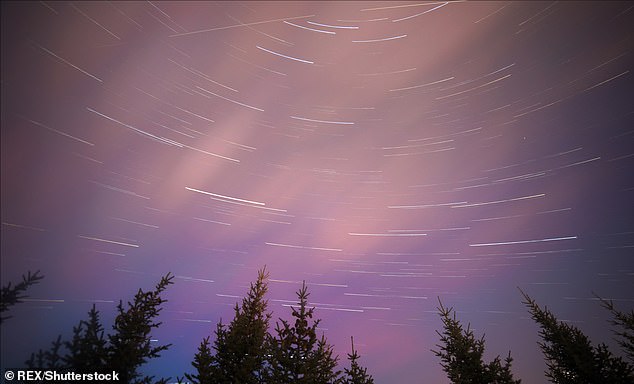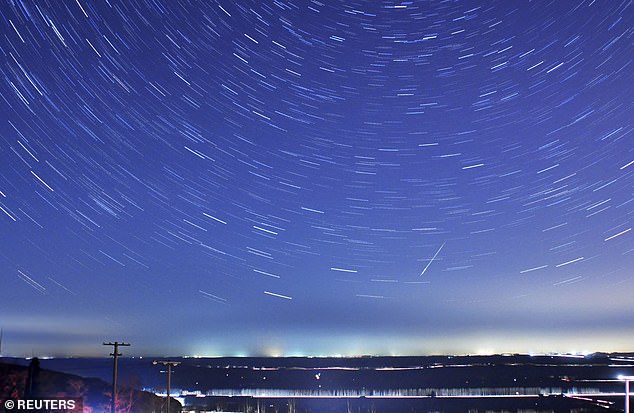Quadrantid Meteor Shower will peak this evening with up to 80 shooting stars every hour
>
One of the most spectacular meteor showers of the year will peak tonight with up to 80 shooting stars per hour streaking across the night sky.
Stargazers will enjoy the exciting but short-lived spectacle of the Quadrantids, famous for producing brilliant “fireball” meteors that leave behind large bursts of light and color that persist longer than your average meteor streak.
The total period of the shower is from December 28, 2022 to January 12, 2023, but it will officially peak tomorrow at 03:00 GMT (22:00 ET today).
However, this year there is a small catch.

Space Rocks: Stargazers will enjoy the exciting but short-lived spectacle of the Quadrantids (pictured in 2019), famous for producing brilliant “fireball” meteorites that leave behind great bursts of light and color that persist longer than the average meteor streaks.
The full moon will light up the sky on Friday, which means that from tonight until early tomorrow morning the sky will be lit by the most fantastic moonlight.
Great for viewing the bright crescent gibbous moon, which will be 94 percent illuminated, but far from ideal for meteor spotting, as moonlight will block out all but the brightest space rocks streaking across the sky.
However, it’s still worth trying to catch a glimpse of the first meteor shower of each year during the night and pre-dawn hours from the Northern Hemisphere.
Unlike most other showers, which originate from debris left behind by comets, the Quadrantids come from the asteroid 2003 EH1, first observed by Chinese astronomers more than 500 years ago.
There are between six and ten ‘sporadic’ meteors a night throughout the year, but during a ‘meteor shower’ this increases dramatically.
“During a shower, Earth passes through a cloud of debris left behind by comets and asteroids, and many more meteors are seen entering the atmosphere,” the Royal Astronomical Society said.
“Unlike many astronomical events, meteor showers are easy to observe and no special equipment is needed.
“A meteor shower is best seen with the naked eye, and a recliner, warm blanket and hot drink make viewing much more comfortable on a cold January night.”
The easiest way to find rain is to look north for the Big Dipper, the distinctive group of seven bright stars and a useful navigational tool.
Then follow the ‘arc’ of the handle of the Big Dipper across the sky to the red giant star Arcturus, which anchors the background of the constellation Bootes, where the meteor shower will appear.
“For the best conditions, you want to find a safe location away from street lights and other sources of light pollution,” the Royal Astronomical Society said.
“Meteors can be seen everywhere in the sky, so it’s good to be in an open space where you can scan the night sky with your eyes.
“In 2023, the maximum rainfall occurs just before the Full Moon, so moonlight will cause some interference.”
The shower’s name comes from Quadrans Muralis, which is an earlier constellation created in 1795 by French astronomer Jérôme Lalande that included parts of Bootes and Draco, but has since fallen out of use.


The easiest way to find rain is to look north for the Big Dipper, the distinctive group of seven bright stars and a useful navigational tool.


The shower’s name comes from Quadrans Muralis, which is an ancient constellation created in 1795 by the French astronomer Jérôme Lalande that included parts of Bootes and Draco, but has since fallen out of use.
Unlike other meteor showers that have a two-day peak, the Quadrantids last only a few hours.
“The reason the spike is so short is due to the thin stream of particles in the shower and the fact that Earth crosses the stream at a perpendicular angle,” NASA said.
At one extreme, up to 200 shooting stars per hour can be seen, but that depends on perfect conditions in the ideal spot on Earth.
The US space agency estimates that at its peak this year, the Quadrantids will produce approximately 80 meteors per hour.
However, the Royal Astronomical Society puts the number between 60 and up to 110 shooting stars per hour.
Meteors are the result of small particles entering Earth’s atmosphere at high speed, typically around 90,000 mph for Quadrantids.
The pieces of debris heat up due to friction with the air and are typically destroyed in less than a second at altitudes above 50 miles.
The superheated air around the meteor glows briefly and is visible from the ground as a streak of light known as a “shooting star.”
If you liked this article…
Stargazers will have the once-in-a-generation opportunity to see a new comet in late January.
Check out this stunning global image of Earth taken by a NASA satellite
In extraterrestrial news, aliens could be discovered 25 years from now when telescopes more powerful than James Webb are built to view distant solar systems.
